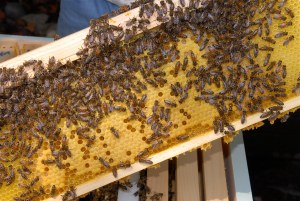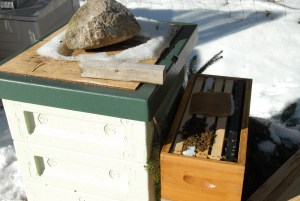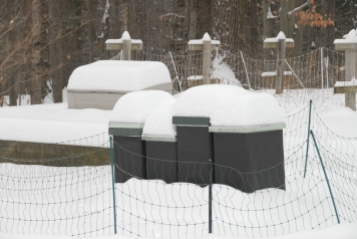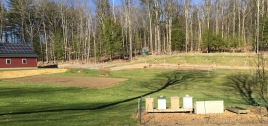
Waiting to check in …
Last Saturday morning found my friend Andy and I each picking up a new package of Italian bees from Dan Conlon at Warm Colors Apiary. As I have stated in earlier posts, I really hate buying packages but I know I can trust Dan. My problem with packages is we are bringing in bees that have already been across the US and back doing almonds, the bees have no relationship to the queen and it’s a great way to bring critters that bother southern bees and drop them right into your apiary. I greatly prefer northern-raised nucs from trustworthy, local beekeepers. The nucs have either overwintered with the queen or, as in the case of “spring nucs”, a northern-raised queen was added to a nuc in late April or early May and has proven herself by laying several frames of healthy brood before the colony is sold. In either instance, the queens are already accepted and the colony has proven itself to be viable prior to arriving in your apiary.

Apiary facing organic orchard, veggie garden and 50+ blueberries eventually needing pollination
So… if I do not like packages, why did I buy one? Pollination. I need bees now as we already have blueberries starting to blossom, as is one of our plum trees. The apples and peaches will be next and the 4 nucs that I have coming will not be ready for at least another 2-3 weeks. Since I order my bees in December and January–before we know if it will be a good or bad winter for bees–betting on nucs is a bit of a gamble. While there certainly are no guarantees in beekeeping, one can readily anticipate a package ordered late fall or early winter will actually arrive come spring. When that package is coming via Dan, it’s as solid as it can possibly be.

So I said good-bye to Andy and Dan and headed home to hive the Italian ladies into a hive consisting of a hive stand, a screen bottom board, a slat board to raise the bottom brood chamber away from the bottom entrance (still cold here at night with a couple of nights dropping into the 20’s) two 10-frame mediums of drawn small cell, a hive top feeder and an outer cover. Yes, I installed the package directly onto drawn small cell comb and did not worry about regressing the bees from large cell to small. I have never done so and have not had a problem.

Didn’t your mother tell you never shake 3 lbs of bees into a box?
As with every package I have ever installed, the bees were incredibly gentle and I never lit the smoker. You may wish to have yours lit and available but I didn’t take the time. You can also have a spray bottle of syrup handy if you so desire. Again, nah…I removed one frame from the lower medium to create space to hang the queen cage and removed all of the frames from the upper, leaving the upper hive body in place. After shaking the bees into the hive,

Make sure cage screen faces open area so bees can feed the queen until she is free
I hung the queen cage in the space created in the middle of the lower hive body when I removed the one frame and replaced all 10 frames in the upper medium. After adding a gallon of 1:1 syrup (1 pint water to 1 pound of sugar), I closed them up, put a wooden entrance reducer on the bottom entrance (opened to about 3 “) turned on the bear fence and walked away. Naturally, you DO have a baited bear fence, right? Shortly later the girls were doing orientation flights in front of their new abode.
Day 4:
Due to weather, on day 4 I finally went out to check on the queen and found her in the upper medium laying eggs. The bees had stored about 1/2 of the syrup and were bringing in pollen to feed the larvae.
Day 7:
Yesterday, the bees had finally stored all of the original gallon of syrup. Cold nights meant cold syrup that had to warm up during the 50-60º days and delayed them a bit.
I decided I want all or at least most of my hives to have a deep bottom brood chamber. I’m thinking it may help in winter so I placed a deep of fresh small cell foundation on top of the 2 mediums and added a gallon of syrup with some Honey-B-Healthy to help stimulate feeding. Packages can build comb quickly so I am hoping they draw out the deep foundation and I can put the deep on the bottom of the stack prior to the nectar flow.
Notes:
I cannot tell you how wonderful it is for us to have bees again! We really missed them and love hearing them fly by when working in the yard, see them hitting the dandelions and just sitting out by the hive watching the entrance. I plan on monitoring the feeder but otherwise leaving them along for the next 10-14 days and let them build up. We should be getting an email about that time saying the nucs are ready and then the apiary will REALLY be buzzing!

Package is in 2nd green hive. Bear fence is solar powered and baited with bacon.
BTW, in the pictures you will see I have 3 additional hives already in place. I did this so the package bees are immediately familiar with the eventual apiary configuration which will hopefully reduce drifting later on. Also, at night, I reduce the entrance down to about 3/4″ and open it to about 3″ during the day to prevent too much congestion at the entrance.
I hope your colonies are quickly building up and that spring has finally arrived to stay! If you were lucky enough to have overwintered any nucs, get them hived and be ready to add supers for their growth spurt!
The next post will be about the apiary plan for 2017.
Keep your bees buzzin’!

































































